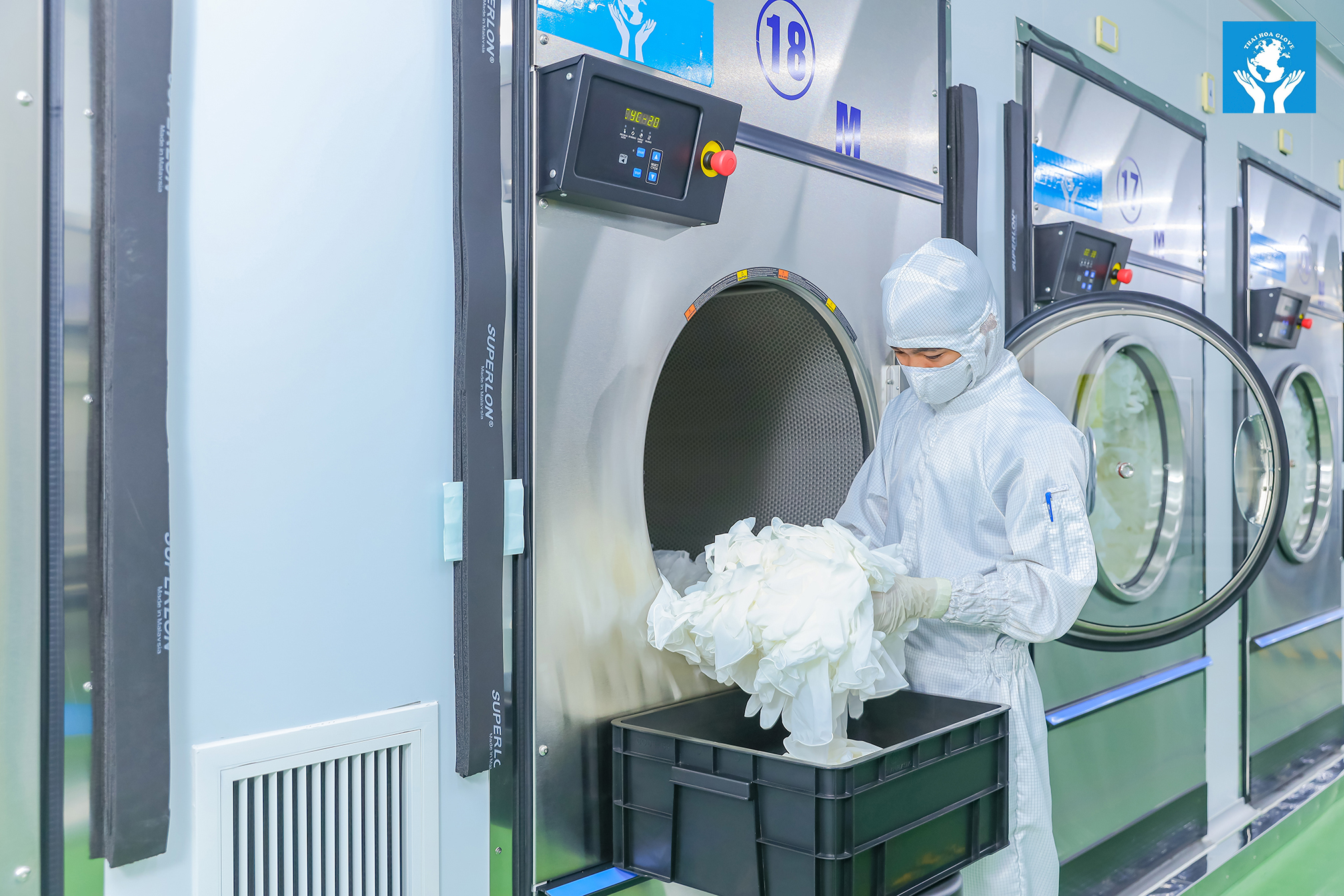Post-Vulcanization Processing Workshop: Enhancing the Quality and Cleanliness of Cleanroom Gloves
After the forming and vulcanization stages, the semi-finished gloves may still contain impurities and residual chemicals that could affect the quality and cleanliness required in cleanroom environments. The post-vulcanization processing workshop plays a critical role in removing these contaminants while also performing any special surface treatments (if applicable) to complete the product before final inspection and packaging.
This is a vital workshop that demands strict processes and rigorous quality control systems to ensure the gloves meet the highest standards of cleanliness and performance required by the cleanroom industry.
1. Glove Washing and Cleaning:
The first and most critical step in the post-vulcanization processing workshop is washing and cleaning the gloves. The main objective of this process is to remove:
Residual Chemicals: Leftover substances from the vulcanization process or earlier stages.
Surface Contaminants: Dust, excess polymer particles, or other impurities that may have adhered to the glove surface during production.
Ions: Metallic ions that could interfere with sensitive cleanroom operations (e.g., electronics manufacturing).
The washing and cleaning process typically involves multiple stages using various solutions and methods:
Pre-Washing: Uses clean water or mild detergent solutions to remove large particles and initial powder residues.
Chemical Washing: Employs specialized chemical solutions to eliminate ions and residual chemicals. Concentration, temperature, and washing time are strictly controlled.
DI Water Rinsing: Gloves are thoroughly rinsed multiple times with DI (deionized) water to ensure complete removal of cleaning agents and metal ions. The DI water quality is regularly monitored to ensure high purity.
Drying: After washing, gloves are completely dried using hot air drying systems or other controlled drying methods to avoid recontamination. Drying temperature and duration are adjusted to preserve glove quality.
The entire washing and cleaning system is designed to be automated, with continuous conveyor belts and multiple tanks to ensure processing efficiency and consistency.
2. Special Surface Treatments (Optional):
Depending on the specific product requirements and application, gloves may undergo special surface treatments after the washing and cleaning process:
Chlorination:
Treating the glove surface with chlorine reduces tackiness, making the gloves easier to don and doff. For latex gloves, this process also lowers protein content, minimizing the risk of allergic reactions. Chlorination must be strictly controlled in terms of chlorine concentration and treatment duration, followed by thorough neutralization and rinsing to remove residual chlorine.
Polymer Coating:
Applying a thin layer of polymer (e.g., polyurethane) to the inner surface of the gloves helps enhance donning comfort, reduces friction, and can improve chemical resistance. The coating process requires precise control over the coating thickness and subsequent drying to maintain product consistency.
Anti-static Treatment:
For use in the electronics industry, gloves often require anti-static properties to protect sensitive components. This can be achieved by dipping gloves into a solution containing anti-static agents or by incorporating such agents into the original polymer formulation.
Surface Texturing:
To enhance grip and handling, gloves can be textured to increase surface friction.
These surface treatment steps must be performed in a controlled environment to prevent contamination and ensure uniformity across all products.
3. Post-Treatment Quality Inspection:
After the washing, cleaning, and any optional surface treatments are completed, the gloves undergo a more rigorous quality inspection focused on evaluating the effectiveness of the post-vulcanization processes:
Cleanliness Testing:
Measures include particle count, non-volatile residue (NVR), and ion content on the glove surface to ensure compliance with cleanroom standards (e.g., ISO Class). These tests are typically conducted in a cleanroom using specialized equipment.
Residual Chemical Testing:
Analytical methods are used to confirm that no residual chemicals remain above permissible limits after the washing and cleaning stages.
Surface Property Testing:
Evaluates the effectiveness of processes such as chlorination, polymer coating, or anti-static treatment—such as by measuring surface resistance or coating uniformity.
Visual Inspection:
A repeat assessment of the glove’s shape, dimensions, and surface defects ensures that no damage occurred during the post-treatment processes.
Gloves that do not meet the required standards are discarded at this stage.
4. Sorting and Transfer:
Gloves that pass the post-treatment inspection are sorted according to batch, size, and specific customer requirements. Once sorted, they are transferred to the final quality inspection and packaging department for the next stages of processing.
Conclusion:
The post-vulcanization treatment workshop plays a critical role in ensuring the quality and cleanliness of cleanroom gloves. The washing, cleaning, and optional surface treatment processes carried out in this workshop are essential for removing contaminants and refining the necessary product characteristics. Strict procedures, robust quality control systems, and adherence to environmental and occupational safety standards are key factors that enable the production of cleanroom gloves that meet the most stringent requirements. These gloves effectively protect sensitive production processes in cleanroom environments.



